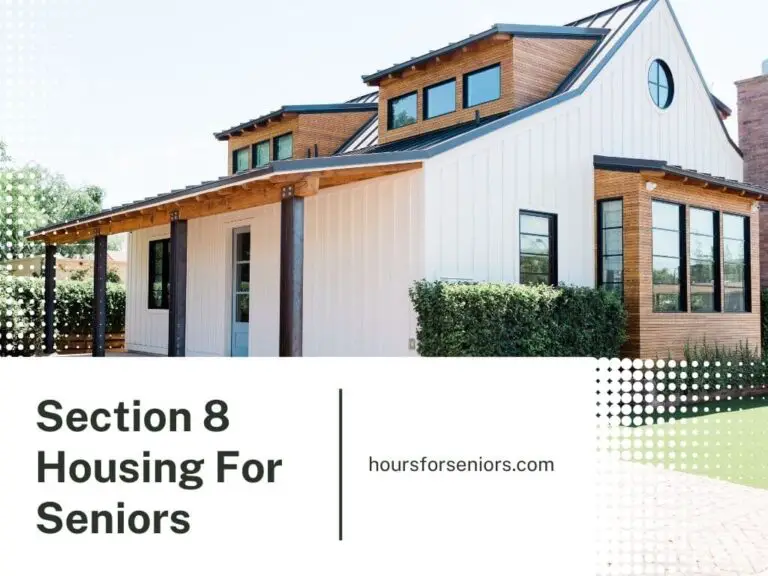Section 8 for Disabled Seniors: Eligibility, Benefits, and Application Process
In the United States, seniors with disabilities face a significantly higher poverty rate compared to those without disabilities. Recent data from the US Census Bureau reveals that approximately 12.8 million disabled individuals were living in poverty in 2018, which accounts for approximately 28.3% of the disabled population. Among these vulnerable groups, disabled seniors encounter unique challenges, necessitating a closer examination of housing assistance programs tailored to their needs.
The Department of Housing and Urban Development (HUD) plays a crucial role in providing support to disabled individuals seeking emergency housing assistance. In 2018 alone, nearly 4.6 million disabled people received aid through HUD’s programs.
To address the housing needs of disabled seniors, one key program is Section 8, which offers subsidized housing assistance. A significant majority (over 80%) of households benefiting from Section 8 have an annual income of less than $20,000. 43% of participating households in Section 8 have at least one disabled family member, highlighting the urgent need for suitable housing options for disabled seniors.
While millions of Americans currently benefit from housing assistance programs, it is essential to acknowledge that hundreds of thousands remain on waiting lists, eagerly awaiting aid. Therefore, it becomes imperative to explore the eligibility criteria, benefits, and application process specifically tailored to disabled seniors seeking assistance through Section 8.
As the number of older adults in the US is projected to double by 2060, with this demographic representing nearly a quarter of the population, housing authorities must adapt to the unique needs of aging individuals. A growing number of public housing households include a member with a disability, emphasizing the necessity for specialized services and programs.
In this article, we delve into the world of Section 8 housing assistance for disabled seniors. We explore the eligibility requirements, outline the benefits available to this vulnerable population, and provide a comprehensive guide to navigating the application process. By understanding the opportunities and support provided by Section 8, disabled seniors can secure safe, affordable, and accessible housing to enhance their quality of life.

What Is Section 8 Housing?
Section 8 Housing is a program administered by the United States Department of Housing and Urban Development (HUD) to provide housing assistance for low-income households. Eligible households are issued a voucher that pays a portion of their rent directly to the landlord, with the tenant responsible for the remaining rent payments. Applications for the program are managed by local Public Housing Agencies (PHAs) with eligibility based on income, household size, and other criteria.
To qualify for Section 8 assistance, households must have an income that does not exceed 80% of the median income in their area. Priority on the Section 8 waiting list is given to certain needy groups.
Approximately 4.8 million U.S. households currently receive housing assistance, with 1.3 million renting subsidized Section 8 apartments and 2.1 million benefiting from housing vouchers.
However, the demand for Section 8 housing often surpasses the available vouchers, leading to long waiting lists and closed applications in some areas. Section 8 participants who continue to meet the eligibility criteria can remain in the program indefinitely, although the average length of stay is around 6.6 years.
Section 8 rentals can accommodate households of various sizes, but on average, eligible families consist of about two members. Most households in subsidized housing earn less than $20,000 per year, categorizing them as extremely low-income.
It is common for families in affordable housing to apply for other government benefits, particularly those receiving Temporary Assistance for Needy Families (TANF) or Supplemental Nutrition Assistance Program (SNAP).
Among the recipients of Section 8 housing, families with children make up 43% of the total, with 42% of these families headed by a female.
Seniors account for 10% of households in Section 8, and approximately 43% have at least one disabled family member.
The majority of households utilize a Housing Choice Voucher, which is the most popular form of tenant-based Section 8 assistance.
Over the years, the success rate of Section 8 participants finding suitable low-income housing has decreased from 81% to 69% since the 1980s, primarily due to insufficient federal funding.
This underscores the ongoing challenge of providing adequate housing support to disabled seniors and other vulnerable populations through the Section 8 program.
What Are The Requirements To Qualify For Section 8 As A Disabled Senior?
The Section 8 Housing Choice Voucher Program provides rental assistance to low-income, very low-income, and extremely low-income households. To qualify, households must meet one of these income classifications, where low-income families earn up to 80% of the area’s median income, very low-income households earn up to 50%, and extremely low-income households earn approximately 30%. Disabled seniors may qualify for this assistance even if their income exceeds these requirements, depending on availability of resources in their area.
Eligibility for a housing voucher is determined by the Public Housing Authority (PHA) based on various factors, including total annual gross income and family size. The program is open to US citizens and certain categories of non-citizens with eligible immigration status.
Generally, the family’s income should not exceed 50% of the median income for the county or metropolitan area where they choose to live.
The PHA is obligated by law to allocate 75% of its vouchers to applicants whose incomes do not surpass 30% of the area median income. These median income levels, which vary by location, are published by the Department of Housing and Urban Development (HUD).
To determine program eligibility and the amount of housing assistance payment, the PHA collects information on family income, assets, and composition. This information is then verified through local agencies, employers, and banks.
If the PHA determines that a disabled senior’s family is eligible, their name will be placed on a waiting list, unless immediate assistance is available. Once their name reaches the top of the waiting list, the PHA will contact the family and issue them a housing voucher.
The Public Housing Authorities (PHAs) also establish their own criteria for emergency placement, which may include considerations for individuals with disabilities. Various factors can increase an applicant’s priority status on the waiting list.
Specifically, disabled seniors who are aged 65 years and above may be granted higher priority on the housing list. The number of additional qualifying categories a disabled senior falls under determines their level of priority for Section 8 assistance.
It is important for disabled seniors to reach out to the PHA serving their community to obtain specific income limits for their area and family size, as this information can vary depending on location.
Where Can You Find Listings For Section 8 Housing?
Listings for Section 8 housing can be found on national, state, and local government websites, as well as housing websites such as Zillow.com, Rently.com, and GOsection8.com. The HUD Resource Locator can also help find affordable housing options, HUD offices, or local Public Housing Authority/Agency (PHA) by ZIP code.
In addition to federal resources, several nonprofit, charitable, and community organizations support disabled individuals in finding affordable and accessible housing. Accessible Space, Volunteers of America, and Mercy Housing are some examples that operate nationwide and offer assistance in different states and cities.
When searching for handicap-accessible apartments, it may also be helpful to leverage personal connections and seek referrals from friends, family, caregivers, medical and support teams, and others in the disabled community.
Considering newer buildings built after March 13, 1991, can provide more accessible features due to the Fair Housing Amendments Act. Although these buildings may have higher monthly rents, they often require fewer additional modifications, resulting in potential long-term cost savings.
As a renter with disabilities, it is essential to review your rights to refine your search and negotiate with potential landlords.
The Americans with Disabilities Act (ADA) protects individuals with disabilities from discrimination and defines disability as a physical or mental impairment that substantially limits major life activities.
The Fair Housing Act ensures that all renters have equal rights, regardless of physical or mental ability. Landlords or property managers cannot deny a rental based on disability or force individuals to take an inaccessible apartment.
While landlords may request documentation of disabilities, they cannot demand medical records or require excessive proof.
Property managers cannot compel tenants to accept non-accessible apartments and must accommodate reasonable requests for making living spaces more accessible. However, the Fair Housing Act does not require landlords to bear the cost of modifications, which may be passed on to tenants.
What Is The Process For Applying For Section 8?
Applying for Section 8 rental assistance involves a multi-stage process to ensure that low-income households, including disabled seniors, have access to safe and suitable housing.
Administered at the local level by public housing authorities (PHAs), the Housing Choice Voucher (HCV) program provides pays a substantial portion of the rent directly to the landlord, while the tenant is responsible for the remaining amount based on payment standards.
To begin the application process, individuals must complete a preliminary application. PHAs may have different procedures, which can be found on their applicant portal. The preliminary application requires specific information, including:
- the applicant’s name,
- current address,
- family size,
- date and time of application,
- ethnicity of the head of the household, and
- annual income.
Once the preliminary application is reviewed by the PHA, applicants are either added to the waiting list or their application is denied.
If approved, the next step involves filling out a full application, which gathers comprehensive details.
The full application requires information about household income, including all sources such as wages, overtime pay, bonuses, pensions, Social Security benefits, disability benefits, child support, and alimony.
Dependent information must be provided for each household member, including children, disabled family members, and elderly family members.
Financial information, including banking details, is necessary for data verification.
Applicants need to provide contact information for previous landlords, disclose any previous arrests related to drugs or alcohol, provide details about prior evictions from public housing, estimate dependent-related expenses, and submit a self-certification of accuracy for the information provided.
The application can be submitted online, in person, by phone, by mail, or by fax, depending on the local PHA’s procedures. Applicants should contact their local public housing authority to obtain the appropriate forms and seek assistance from customer service.
Applicants should apply with the PHA serving the area they desire to live in. Applying with multiple PHAs simultaneously may increase the chances of approval. Waiting lists open and close depending on housing unit availability, so it is advisable to check with the PHAs of interest to determine if they are accepting applications.
Common reasons for Section 8 application denial include not meeting eligibility criteria such as income requirements, college enrollment, or immigration status. Convictions for criminal activity within public housing, previous evictions from public housing within the last five years, and outstanding balances with any PHA can also lead to denial.
The final decision to approve or deny an application rests with the local PHA, and they may consider mitigating circumstances.
In the event of a denial, applicants have the option to appeal the decision. The PHA will provide a formal letter outlining the denial’s reasoning and instructions for requesting an informal appeal. During the appeal, a reviewer examines the applicant’s case and determines if the decision was an error. Submitting a statement explaining the merits of the case can support the appeal.
Do You Have To Pay A Rent Increase When Moving To Section 8?
Section 8 tenants may see a rent increase if their income increases, they move to a different apartment, or if their Housing Authority approves a higher rent than the payment standard. These increases must be accompanied by a 30-day written notice, and tenants with disabilities may request additional assistance. A landlord must also receive permission from their Housing Authority to increase the rent on their property.
Generally, landlords cannot unilaterally decide to raise your rent without following the proper procedures. They must submit a formal request for a rental increase to the governing housing authority and await approval.
Tenants are not obligated to pay higher rent unless they receive written notification from the housing authority instructing them to do so. Rent increase requests that are deemed unreasonable or exceed fair market standards are typically rejected.
However, it is worth noting that tenants may still experience rent changes in certain situations.
Landlords may need permission from the Housing Authority to raise the rent, but tenants might face rent increases due to factors such as increased household income, moving to a different unit within the same building, or changes in payment standards approved by the Housing Authority.
For tenants in Section 8 properties, rent can only be increased once per year, specifically on their re-certification date. It is crucial for landlords to provide a written 30-day notice to tenants regarding any rent increase.
In most cases, if a landlord’s requested increase is approved by the Housing Authority, it does not alter the tenant’s portion of the rent. However, if the increase exceeds the payment standard, tenants may be required to pay the additional amount.
There are specific circumstances where tenants may face substantial rent increases. If the Department of Housing and Urban Development (HUD) lowers the fair market rents, Section 8 tenants might experience larger rent hikes due to property standards.
In such cases, tenants must receive a 90-day written notice regarding the increase. These unique circumstances can potentially push a tenant’s rent above the 40% income threshold allowed in this type of housing.
For tenants with diagnosed disabilities, the rules may differ. They may have the option to request additional assistance or disability accommodations based on their specific needs in the event of a rent increase. The notification times for these circumstances remain the same.
It is generally challenging for landlords to obtain a rent increase for their Section 8 property, given the strict regulations and oversight in place.
What Is The Maximum Rent Subsidy Amount?
The Maximum Rent Subsidy Amount is the lesser of the Fair Market Rent (FMR) set by the Department of Housing and Urban Development (HUD) for comparable units in the area or a rent that does not exceed 30 percent of the adjusted income of a family whose annual income equals 65 percent of the median income for the area, as determined by HUD.
For rental projects with five or more HOME-assisted rental units, 20 percent of the HOME-assisted units must be occupied by very low-income families and have a rent that does not exceed 30 percent of the family’s adjusted income.
For unit sizes larger than four bedroom, the FMR is calculated by adding 15 percent to the four bedroom FMR for each extra bedroom.
The maximum rent subsidy amount under Section 8 varies based on several factors, including the town of residence and income level. It is important to consider four main criteria when determining the voucher amount for disabled seniors:
Fair Market Rent
The Department of Housing and Urban Development (HUD) calculates the Fair Market Rent (FMR) annually for over 2,500 areas in the country. HUD determines the FMR by analyzing rental units rented in a specific area over the past 15 months. Units less than two years old, assisted living units, and those rented below-market rates are excluded from the calculation.
HUD sets the FMR at the 40th percentile for most areas, meaning 40 percent of units rented for less than this amount and 60 percent for more. In some metropolitan areas, the FMR may be set at the 50th percentile.
Payment Standard
Local Public Housing Authorities (PHA) use the HUD-set FMR as a guide to determine their payment standard. The payment standard represents the maximum amount the PHA is willing to pay for each number of bedrooms, typically ranging from 90 to 110 percent of the FMR.
Tenant Portion
Disabled seniors receiving housing choice vouchers contribute a tenant portion towards the rent. The tenant’s contribution is calculated as the greater of the following: 30 percent of their monthly adjusted income, 10 percent of their monthly gross income, the welfare rent, or the minimum rent amount set by the PHA.
The tenant directly pays the tenant portion to the landlord. If the rent for the unit exceeds the PHA’s payment standard, the tenant may choose to pay more, as long as it doesn’t exceed 40 percent of their monthly adjusted income and is approved by the PHA.
Utility Allowance
If utilities are included in the monthly rent, the PHA includes an amount for utilities when issuing the housing choice voucher. In cases where utilities are not included, the PHA may provide a separate utility allowance to the tenant or issue a utility reimbursement directly to the tenant or utility company.
What Are The Benefits Of Section 8 For Disabled Seniors?
Disabled seniors can benefit from Section 8 in several ways:
Affordable Housing
Section 8 helps disabled seniors secure safe and affordable housing. The program subsidizes a portion of their rent, making it more affordable and enabling them to access housing in communities of their choice.
Housing Flexibility
With Section 8, disabled seniors are not limited to specific housing options. They can choose their own housing, including apartments, single-family homes, or townhouses, as long as the landlord is willing to participate in the program.
Accessibility Modifications
The program allows disabled seniors to request reasonable accommodation from landlords to make their rental unit more accessible. This may include installing grab bars, ramps, or other modifications that facilitate mobility and independence.
Supportive Services
Section 8 voucher holders may be eligible for additional supportive services through local housing agencies or community organizations. These services can include case management, health care coordination, transportation assistance, and social activities, which can enhance the well-being of disabled seniors.
Rental Assistance Stability
Section 8 provides ongoing rental assistance, ensuring that disabled seniors have stable housing. This stability is particularly important for individuals with fixed incomes or limited financial resources, as it reduces the risk of homelessness or housing insecurity.
Aging in Place
Section 8 enables disabled seniors to age in place, meaning they can continue living in their preferred community or neighborhood rather than being forced to relocate due to financial constraints. This can help maintain social connections, access to local services, and proximity to family and friends.
Section 8 is a needs-based program, and benefits, eligibility criteria, waiting lists, and subsidy amounts can vary by location.
What Are The Limitations Of Section 8 For Disabled Seniors?
While Section 8 aims to provide affordable housing options for disabled seniors, there are certain limitations to be aware of. Here are some of them:
Funding limitations
Section 8 is subject to limited funding, which means that not everyone who qualifies for the program will receive assistance. The demand for affordable housing often exceeds the available resources, resulting in long waiting lists and limited availability of vouchers.
Eligibility requirements
Disabled seniors must meet specific eligibility criteria to qualify for Section 8 assistance. These requirements may include income limits, citizenship or eligible immigration status, and compliance with the program’s regulations. The eligibility process can be competitive and may exclude some individuals due to limited resources.
Waiting lists
Due to the high demand for affordable housing, many areas have lengthy waiting lists for Section 8 vouchers. Disabled seniors who apply may have to wait for an extended period before receiving assistance. The waiting time can vary significantly depending on the location and availability of vouchers.
Limited housing options
Although Section 8 vouchers allow participants to choose their housing, not all landlords accept these vouchers. Some landlords may be unwilling to participate in the program due to administrative requirements or other reasons. As a result, disabled seniors may face limited housing options, particularly in areas with low rental vacancy rates.
Rent affordability
While Section 8 subsidies help reduce the rent burden for eligible individuals, participants are still responsible for paying a portion of the rent. The required tenant contribution is typically based on the individual’s income, which means that some disabled seniors may struggle to afford the remaining portion of the rent even with the voucher assistance.
Administrative complexities
The Section 8 program involves complex administrative processes, both for applicants and landlords. The application process, recertification requirements, and ongoing compliance with program rules can be challenging to navigate, especially for disabled seniors who may have limited mobility or other disabilities.
How Can Disabled Seniors Receive More Assistance Through Section 8?
Disabled seniors in the United States have access to various housing assistance programs in addition to Section 8. These programs aim to provide affordable and accessible housing options, support independent living, and offer financial aid.
One such program is the United States Department of Housing and Urban Development’s Section 811, which subsidizes rental housing opportunities for individuals with disabilities, enabling them to live independently within their communities. Through Section 811, disabled seniors pay a portion of their rent, usually around 30%, while receiving appropriate supportive services.
In addition to Section 8, disabled seniors can also benefit from the National Housing Trust Fund. This fund primarily focuses on helping non-elderly and low-income families maintain decent housing. Approximately 10% of the fund is allocated to rental housing, while the remaining portion assists the disabled, non-elderly, poor, and first-time home buyers. State governments distribute the funds through both for-profit and not-for-profit organizations, ensuring compliance with established guidelines.
Disabled seniors seeking housing assistance can also explore social security disability housing programs. These programs, such as Section 8 Housing Choice Vouchers and the Low-Income Home Energy Assistance Program (LIHEAP), provide financial support and resources to help individuals with disabilities secure affordable and accessible housing.
To qualify for these programs, applicants must have documented disabilities and meet specific income requirements, typically falling below a certain threshold based on the Federal Poverty Level (FPL) or a percentage of the Area Median Income (AMI).
Disabled seniors who already receive Social Security Disability Insurance (SSDI) or Supplemental Security Income (SSI) may also be eligible for housing assistance programs. However, they still need to meet the specific requirements of each program, including income limits and disability documentation.






